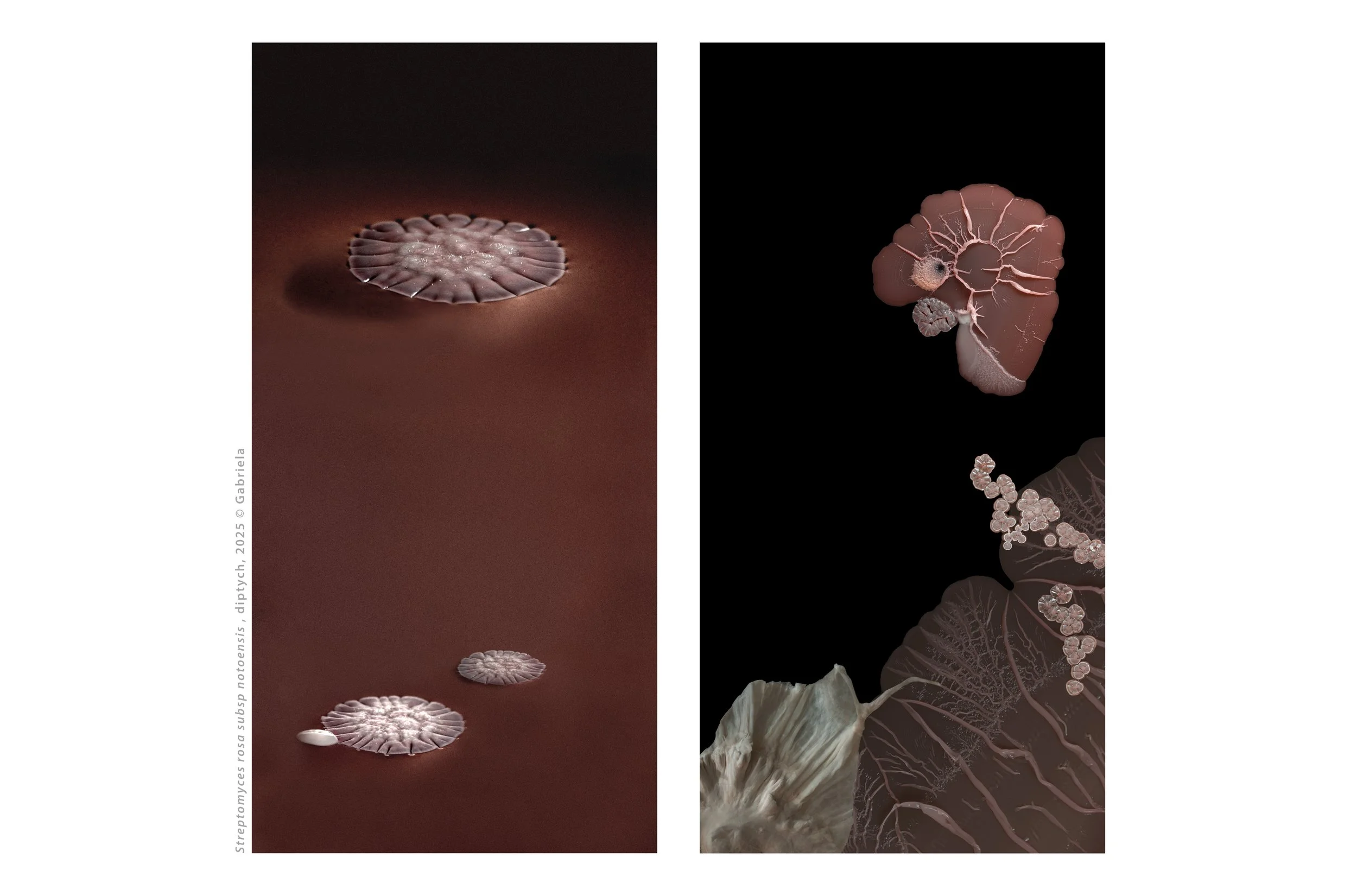Streptomyces rosa subsp. notoensis – Color, Pigment, and Healing Power
Hidden in the soil, delicate networks of bacterial filaments quietly recycle life’s building blocks. Among them lives Streptomyces rosa subsp. notoensis, a bacterium that paints the world in striking shades of pink while producing compounds with remarkable medical potential. More than a microbial curiosity, it embodies the dual nature of beauty and utility – a microbe whose colors captivate the eye and whose chemistry may help heal the body.
A specialist underground
Like its relatives in the Streptomyces genus, S. rosa subsp. notoensis thrives in the soil. It grows not as single cells but as branching filaments, weaving through particles of earth in ways that resemble fungal mycelia. These fine threads break down organic matter, recycle nutrients, and release molecules that influence the balance of surrounding microbes.
What makes S. rosa subsp. notoensis stand out, however, is its palette. The bacterium produces vivid pink and red pigments that stain both its colonies and the soil it inhabits. These pigments are not just decorative: they are often linked to antibacterial or antifungal activity, helping the organism defend itself in crowded microbial communities. In the soil, color and survival are inseparably connected.
Pigments with a purpose
To microorganisms, pigments are tools. They can shield against damaging ultraviolet light, act as antioxidants to protect delicate cell structures, or serve as chemical signals that mediate microbial communication and competition. For S. rosa subsp. notoensis, pigments double as weapons in microbial turf wars, inhibiting the growth of nearby rivals.
For researchers, this duality makes pigments especially intriguing. On one hand, they may inspire new natural dyes for textiles, food, or cosmetics – vibrant colors sourced directly from nature rather than synthetic chemistry. On the other, they may reveal new compounds with pharmaceutical potential. The pigments of S. rosa subsp. notoensis exemplify this versatility, bridging the worlds of aesthetics, technology, and medicine.
Healing chemistry
The Streptomyces family is legendary in medicine. Many of our most important antibiotics – streptomycin, tetracycline, erythromycin – were first discovered in these soil-dwelling bacteria. Each new Streptomyces strain offers the possibility of additional compounds, and S. rosa subsp. notoensis has not disappointed.
Its claim to fame is a set of red-colored molecules known as nanaomycins. These antibiotics can fight certain bacteria and fungi, adding to our arsenal at a time when antibiotic resistance is eroding the effectiveness of existing drugs. In the global struggle against resistant infections, every new antibiotic counts.
But the potential of nanaomycins may extend beyond infection control. Early research suggests that some nanaomycin compounds show activity against cancer cells, particularly in studies on bladder cancer. Although such applications remain experimental, the possibility that a soil bacterium could provide leads for future cancer treatments demonstrates the profound biomedical significance hidden beneath our feet.
A bacterium that inspires
The story of S. rosa subsp. notoensis illustrates how beauty and function often go hand in hand in nature. Its vivid colors capture the imagination, but behind the pigment lies chemistry with the power to heal. In this way, the bacterium bridges the worlds of science and art – reminding us that soil is not inert dirt but a living, creative system filled with inspiration.
Beyond health, its pigments and compounds also spark ideas for sustainability and design. Could we one day color fabrics with bacterial pigments instead of synthetic dyes? Could nanaomycin derivatives inspire new pharmaceuticals? Could natural pigments offer eco-friendly alternatives to chemicals that strain the environment?
By raising such questions, S. rosa subsp. notoensis proves that microbes are not only guardians of ecological cycles but also sources of creativity and possibility.
More than color
In the end, Streptomyces rosa subsp. notoensis is more than a bacterium with a splash of pink. It is part of a vast microbial lineage that has shaped medicine, industry, and ecology. Its pigments remind us that survival in the soil is a complex and colorful affair, while its healing chemistry demonstrates that even obscure organisms can contribute to human well-being.
From the ground beneath our feet, S. rosa subsp. notoensis sends a message: beauty, survival, and healing are intertwined – and even the smallest life forms can inspire solutions for our health, our industries, and our imagination.
Text developed in collaboration with Anna Székely, Associate Professor, SLU Swedish University of Agricultural Sciences
